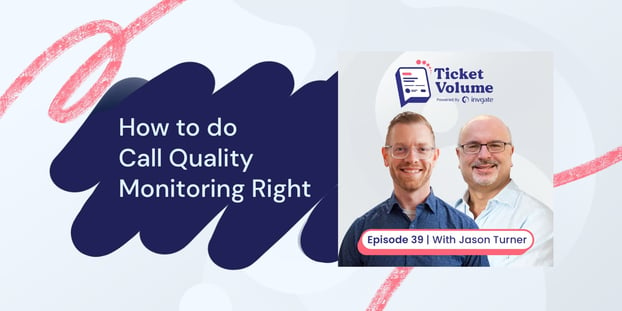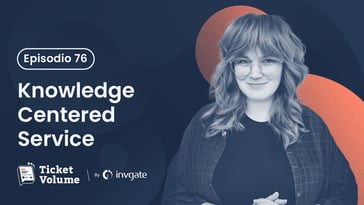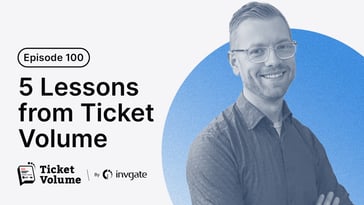Measuring service desk metrics is not the only way to ensure quality on an IT support team. Of course, it's indispensable, but a good help desk manager doesn't draw the line there. Call quality monitoring is another technique to improve service desk quality.
And in order to do it right, Jason Turner – Associate Director of Customer Support at Princeton University – shared his tips and tricks on episode 39 of Ticket Volume, our IT podcast. With more than 20 years of experience in IT support, his focus on improving customer experience during interactions with service desk analysts is a refreshing take on measuring quality.
Keep reading for a quick written recap of the episode – and remember that you can register for our monthly live recordings and ask your questions live!

The ABC of call quality monitoring
In a nutshell, call quality monitoring is evaluating and analyzing the performance of a support team's phone interactions with customers, including outbound call flows, to ensure that they meet or exceed the expected quality standards.
The evaluation process involves listening to calls and identifying areas where the support team performed well and areas that need improvement. In particular, managers will evaluate various factors, such as the representative's tone of voice, communication skills, adherence to scripts or guidelines, the accuracy of information provided, problem-solving abilities, and overall customer experience.
Now, even though call monitoring can be done side-by-side, Turner explained that agents might feel stressed if someone's looking over their shoulder. For this reason, recording calls and evaluating them remotely can be a good alternative.
|
|
Jason Turner |
Benefits and challenges of call recordings
Call recordings are a fundamental tool in call quality monitoring, offering several benefits that enhance the overall effectiveness of call centers. These recordings provide concrete evidence when escalating issues, offer more context than screenshots or written notes, and make it easy to access and embed recordings into incidents through unique URLs.
However, implementing call recordings also presents certain challenges that must be addressed. One significant challenge is the time-consuming nature of listening to entire audio recordings. Another issue is the inability to determine what a call center agent does when they put customer phone calls on hold, as the recording only captures dead air. To address this challenge, Turner suggested video recordings.
How video recordings can improve call quality monitoring
Video recordings can help analyze dead air to understand what agents do while the customer waits. Analysts could be consulting knowledge bases, prior tickets for solutions, or instant messaging peers for advice. Moreover, Video recordings provide a more comprehensive view of agent activities during customer interactions.
Additionally, video recordings offer several other benefits that aid the analysis process for help desk managers:
-
Efficient analysis: They enable managers to cut out small talk and fast-forward through niceties, focusing on the core of the interaction.
-
Sentiment analysis: Video recordings can convert speech to text, allowing managers to read as well as listen to calls. This feature enables deeper sentiment analysis and the flagging of negative interactions.
Video recordings are also valuable because center managers can use them for training purposes. For example, the guest explained how sharing a recording of a call that went south can help the support team learn how to de-escalate situations and focus on resolving problems effectively.
Leveraging technology for effective call quality management
Today, call centers are increasingly adopting advanced technologies to enhance their quality monitoring processes. Call quality monitoring software and call recording software are giving managers new, improved tools to assess and improve customer service calls.
Key features of modern call monitoring practices include:
-
Speech analytics: To analyze customer sentiment and identify areas for improvement.
- Conversation intelligence software: For deeper insights into customer interactions and communication patterns
-
Artificial intelligence: For automated scoring and trend identification.
-
Integration with Key Performance Indicators (KPIs): To align quality standards with business outcomes.
These tools provide valuable insights that help call center managers and quality assurance teams to:
-
Evaluate agent performance: The tools provide a greater overview of call agent productivity, customer service quality, and even agent behavior. This information can then be translated into detailed and actionable feedback.
-
Identify agent training needs: They can help pinpoint the areas where call center agents require additional support or education.
-
Improve customer satisfaction: By addressing recurring issues and enhancing the overall service quality.
Call center quality monitoring is vital for improving agent performance
Without a detailed analysis of every phone call your customers receive and make from your sales agents, you cannot know whether your services meet or exceed your expectations.
Call center managers might hire brilliant agents, but ensuring that all the right people learn how to adapt to each client situation, reduce tension, display empathy, and turn around negative feelings can help maximize agent effectiveness. Call center Quality Monitoring Software can help leaders track agents' performance in real time and analyze calls.
Balancing Quality Assurance and employee engagement in call centers
While maintaining high-quality standards is crucial, it's equally important to foster a positive work environment that promotes employee engagement and productivity. Effective call center quality monitoring strikes a balance between these two aspects.
Strategies to achieve this balance include:
-
Involving agents: In the quality assurance process to increase buy-in and understanding.
-
Constructive feedback: Using quality monitoring as a tool for constructive feedback and personalized agent training.
-
Recognition and rewards: Recognizing and rewarding excellent customer service to boost morale.
-
Agent feedback: Incorporating agent feedback into the development of quality standards.
When call centers focus on both quality assurance and employee engagement, they can improve agent productivity and reduce turnover, create a culture of continuous improvement, and align contact center operations with broader business goals.
The bottom line
This is just a short recap of the 39th episode of Ticket Volume with Jason Turner, but there's so much more to go through! So, catch up on the full chat with InvGate Product Specialist Matt Beran to learn more about leveraging call quality monitoring to improve your service desk team's performance.
You can find the full episode on Apple Podcasts, Spotify, YouTube, or your favorite podcast platform. And remember to subscribe if you want to be a part of the monthly live recordings!















